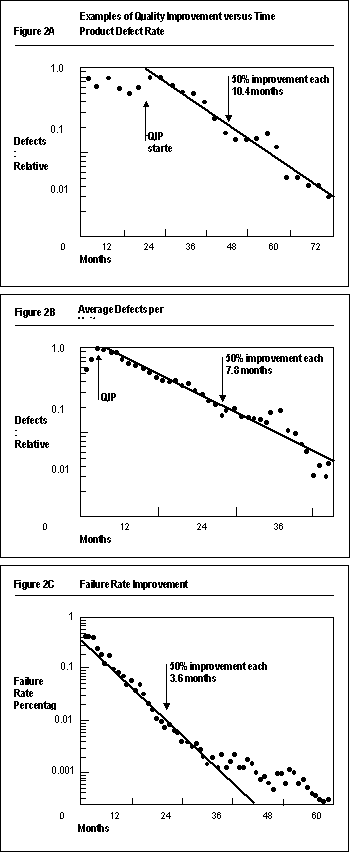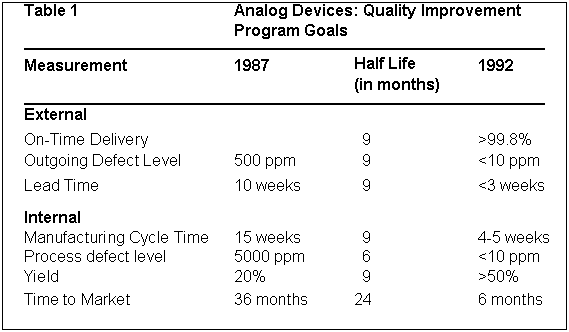Excerpts from: Ray Stata, Organizational
Learning ¾ The Key to Management Innovation, Sloan Management Review, Volume 30, Number 3, Spring
1989, pp 63-74:
“…
Quality Improvement:
A Methodology for Change
Even
when there is a strong consensus for change, achieving it is easier said than
done. For example, another imperative reinforced by the planning process at
Analog Devices was the need to improve customer service, product quality, and
yields. Of course this concern was not new. Since the early 1980s, as our
customers have gotten a taste of what Japanese electronic companies could
deliver, and as just-in-time JIT) programs have become more prevalent, pressure
has mounted to improve performance. What was new was the realization of just how
much we had to 'improve to meet our customers' expectations, and how little time
we had to do it. On-time delivery of products that work has become the major
factor in vendor selection and performance evaluation. We can no longer win by
the sheer force of being first to market with the latest products and
technology.
Quality
improvement, or total quality control as it is often called, is a management
methodology for achieving improvement and change. In 1983 we began to introduce
quality improvement methods at Analog Devices. We decided to focus our attention
on product quality, on-time delivery, lead-time, yields, and new-product time to
market. We went to seminars, read books, gave speeches, and introduced
information systems to measure our performance. But three years into the mission
we were not getting very far very fast. I had an uneasy feeling that I did not
know what I was supposed to be doing to lead this effort and that there were a
lot of other dedicated managers in the same boat.
We
knew all about error detection and correction and about doing it right the first
time. But we did not have any notion of what rate of improvement was
satisfactory or what we could do to accelerate the 'improvement process.
Considering that many Japanese companies had been working the quality
improvement game for more than twenty years and that they are not standing still
even now, we had a Justifiable sense of discomfort.
Because
of our "lean and mean" attitude toward staff functions, we had
resisted the addition of a quality improvement staff. Line managers were
expected to learn on their own. But learn from where, learn from whom? Reading
books and going to seminars was not enough. So we finally broke down and
recruited a quality improvement professional to teach us how to tap the
mainstream of experience and knowledge that is rapidly accumulating in this
field and to help our managers become more expert practitioners. Only then did
the organization begin to see real progress. One of the early lessons I learned
from our quality guru was that there is a rational basis on which to set
standards for rates of improvement. From his consulting experience, our director
of quality improvement had documented case histories where quality improvement
methodology had worked. What these cases showed was that while the rate of
improvement varies from case to case, the rate in each case is remarkably
consistent over an extended time period. Figure 2 shows three actual businesses'
learning rates. Note that in the first case, performance improved by 50 percent
every 10.4 months, 'in the second case every 7.8 months, and in the third case
every 3.6 months. He called this characteristic slope of improvement the half
life.
An
analysis of a larger number of case studies indicated that the half life for
improvement fell within a relatively narrow range, usually six to twelve months,
across a wide range of applications.' The reason for this phenomenon is clear
enough when you understand the method by which quality improvement is achieved.
The
method is deceptively simple. For example, as I mentioned, one of our goals was
to reduce the percentage of orders shipped late. To do this we assembled a team
from various organizations involved with customer service to analyze the causes
of lateness. For each late shipment we determined the cause, and then we plotted
their distribution. We found that a relatively small number of causes was
responsible for 50 percent of the problems.
Next
we assembled problem-solving teams to attack these major causes of lateness.
When the cycle was completed, we repeated the process by prioritizing the causes
for So percent of the remaining problems and then eliminating those causes. This
cycle was repeated again and again; each time the most important remaining
problems were identified and resources were focused on solving them.
In
this example, as in others using this method, the slope of the learning curve is
determined by how long it takes to identify and prioritize the causes of the
problem and to eliminate those causes. The skills of the people and the level of
resources do have an impact, but surprisingly the time required for each cycle
of improvement is largely a function of the complexity and bureaucracy of the
organization. Or, to put quality improvement in the larger context of this
paper, the slope of the characteristic half-life curve is determined by the rate
of organizational learning.
Notice
that this theory of learning differs from the Boston Consulting Group (BCG)
"experience curve" theory that says learning occurs as a function of
cumulative production volume, independent of lapsed time. The quality
improvement theory says that learning, properly managed, occurs as a function of
time, independent of cumulative volume. How else can we explain the success of
the Japanese automobile industry, which learned faster than the U.S. industry
with substantially less cumulative volume? If we combine the two ideas, we can
say more accurately that the slope of the BCG experience curve is determined by
the rate of organizational learning. A steeper experience curve occurring at
lower production volume can soon overcome a more shallow experience curve
occurring at higher volume.
We
know that communication across organizational boundaries is less effective than
within organizational boundaries and that many problems accumulate because of
poor communication. Quality improvement is a way to create temporary
organizational structures, or teams, that cut horizontally across organizational
boundaries and enhance communication and cooperation. It is a way to get people
to think about problems and issues objectively and quantitatively instead of
subjectively and politically. It is a way to separate the vital few problems
from the trivial many-and to focus organizational resources on resolving them.
In short, quality improvement is a way to accelerate organizational learning.
Using
the half-life concept, at Analog Devices we set very aggressive five-year goals
for quality Improvement (see Table 1). The results of continuous improvement
with nine-to-twelve-month half lives over an extended period are awesome. The
first reaction of our organization was to recoil from what looked like
unrealistic objectives. But we reminded our managers that if a company really
gets its quality improvement act together, there 'is no fundamental reason why
these goals cannot be achieved. There are companies in Japan already operating
at these levels on some of these measures. …
…Another
problem with management information systems is that they are strongly biased
toward reporting financial information to stockholders and government agencies.
Unless quality improvement and other more fundamental performance measures are
elevated to the same level of importance as financial measures, when conflicts
arise, financial considerations win out. To address this issue, we designed what
we call a division scorecard that reports only the barest of financial
information and places greater emphasis on quality improvement goals. This
scorecard is used not only to evaluate division performance, but also to
structure division bonus plans.
How
information is displayed makes an incredible difference. Consider, for example,
the format we use to display on-time delivery information (see Figure 3). This
simple summary replaces pages of information that used to be circulated to
managers. With all these pages, the most crucial information was missing-namely,
the half-life trend. Because the information is plotted on a log-linear scale,
the trend is readily discernible. For management purposes, displaying all
divisions together on a single page has great motivational value. A high level
of internal competition exists to generate the fastest learning curve; it is
obvious and embarrassing when you are not performing.
Management
information systems transform data into information and then help managers
transform information into knowledge and knowledge into action. The challenge is
deciding what information and knowledge-in what form-are needed. If we keep
organizational learning in mind as a goal of information systems design, then we
are more likely to generate the information and knowledge that managers need to
take effective action.”


